Our great author, Stuart Miller-Osborne has written a wonderful article on Hungerford and the railways. It is a very interesting and nostalgic read, especially when you are relaxing with a nice cup of tea and a biscuit. Feeling refreshed? Come and visit us at the famous Hungerford Arcade and see what people get excited about!
Rita
One
of the great joys of visiting Hungerford is that you can travel to
the town by either road or rail or, water if you choose to use the
canal.
town is made up really of two main roads. The Bath Road and the
Salisbury Road which meet at the Bear Hotel near the Rivers Kennet
and Dun but if you travel towards the town on the Salisbury Road (the
main High Street), you will as you cross the canal bridge, see the
railway bridge which cuts the town in half.
will also note that Hungerford is partially built on the side of a
hill and this, when the railway was being planned, would have presented
a number of obstacles.
is why for part of its journey through Hungerford the railway was
built on an embankment which can be clearly seen when the railway is
viewed from the main street in the town.
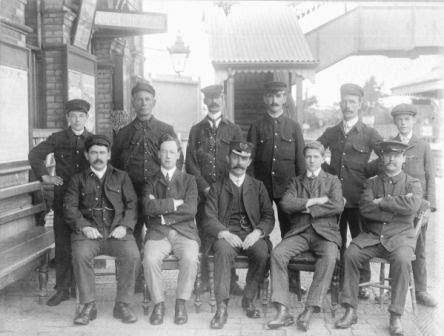 Obviously
Obviouslyif the railway engineers had planned otherwise then the railway would
have been threatened with flooding as the ground at river level would
have acted like a basin when the rivers overflowed, as they were prone
to doing during the nineteenth and twentieth centuries.
my view there is nothing better than being in the High Street when an
express thunders across the bridge at speed. The whole area seems to
rock and shake for a few moments before peace is restored.
railway like the Town Hall, is a part of Hungerford Life and
surprisingly the railway pre-dates our present town hall by some
twenty-five years.
first stirrings were in 1845 when a line from Reading to Hungerford
(via Newbury) was proposed. This was some four years after Brunel’s
main line between London and Bristol was opened in 1841 and by the
December of 1847 Hungerford had become the termini for this double
track broad gauge extension from Reading.
railway even had a turntable so that engines could be turned and this
is how things stayed for the next fifteen years.
1859 it was proposed that the railway be extended beyond Hungerford
for some twenty-four miles to Seend near Devizes where it would be
linked with the Wilts, Somerset and Weymouth Railway.
was then that the railway really began to take shape and the first of
three bridges was constructed over the High Street and the railway
began to resemble the railway we see today.
is a beautiful account of Hungerford in the Bradshaw’s of 1866
which I have copied below. This can be found on the excellent
Hungerford Virtual Museum website along with a number of nostalgic
photographs
Guide [Bradshaw’s Tours, Section II,
1866)
HUNGERFORD.
POPULATION, 2,051
A telegraph
station
HOTEL – Black Bear
MARKET DAY – Wednesday
FAIRS
– Last Wednesday in April and Sept., and first Wednesday in
Oct.
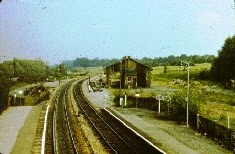
HUNGERFORD is a market town which
stands partly in the county of Berks, and partly in that of Wilts.
The Kennet flows past this town, which opens a communication with the
river Thames on the east, and the Avon and Bristol Channel on the
west. The town principally consists of one long main street, with a
few smaller ones branching from it.
In the centre stands the
market house, over which there is a large room for public business
and here is still preserved the Hungerford Horn, presented to the
corporate body by John of Gaunt. It is made of brass, and is blown
every Horn Tuesday to assemble the inhabitants for the election of
the town constable.
From Hungerford you may follow the
Berkshire Downs round to Reading, past Lambourn, Ashdown (where
Alfred beat the Danes). Uffington Castle, Wayland Smith’s Stone, the
White Horse Hill (893 feet high with the figure of a galloping horse
370 feet long, cut in the chalk). Wantage, along Ickleton
Street (a Roman way on the ridge) to East Ilsley (noted for its great
sheep fairs), and so to Reading, a strip of about 40 or 45 miles,
never to be forgotten by a light-heeled pedestrian.The Berks
and Hants, a railway 24½ miles long, begins here and runs through a
nearly level country. Although the title would seem to imply, it
forms no connection between the two counties named, taking as it does
a westerly direction from the borders of Berks through the very heart
of the county of Wilts.
 In
Inthose far off days you could travel from Hungerford to Devizes quite
easily or change trains at Holt Junction. In time, the Broad Gauge
tracks were changed to Narrow Gauge and the line which had originally
been a single line was doubled.
1896 the original bridge was replaced (This bridge was subsequently
replaced again the 1960s).
fine country station, a goods shed and two signal boxes were also
added.
with most things Victorian, it was a tidy compact set up which seemed
to compliment the nearby Hungerford Common.
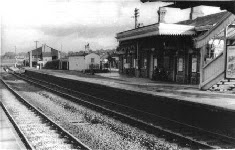 But
Butsadly whilst the line survived the Beeching/Marples cuts in the 1960s, the station did not. It was deliberately left to go to rack and ruin
and the last buildings were demolished in the early 1970s.
we were left with is roughly the station we see today. The initiative
by Network South East in the 1980s can still be seen, although the
spartan waiting shelters are in the process of being replaced.
functional, the state of the current station is a little sad but there is, I hope, light at the end of the tunnel as there are plans to
redevelop the station area, which I trust will include the upgrading
of the station.
 As
Aswith a lot of things these days and after the farce of privatisation, there are so many agencies involved that this might be a lengthy
process. Time will tell.
a way current events are mirroring the pioneering days of Victorian
times. The railway is soon to be electrified to Newbury which I have
mixed feeling about having seen the destruction it caused in the
Hemel Hempstead/Berkhamstead areas in the 1960s.
three reasons. Firstly cost, as there are a large number of small
bridges in the town and beyond.
replace these, (some of which carry just farm tracks), would be very
costly and if the new bridges near Aldermaston are to be the type of
replacements then this would run into enormous opposition.
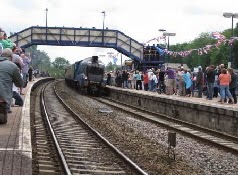 This
Thisalso brings me onto my second point as here in Hungerford, we live in
an Area of Outstanding Natural Beauty (the totems and station signs
at the station advertise this) and any thoughts of electrification
would run into a very strong green lobby and the arguments and
counter arguments would take years and years to resolve.
the current line does not run towards Devizes anymore but towards
Pewsey and
Westbury which are essentially lightly populated areas. It
would not really make proper economic sense to electrify this part of
the line.
I mentioned, Devizes is no longer connected to the railway. The
station site (which I remember from my childhood) is now a car park
and the tunnel that ran into the station is now used in part by a gun
club.
station is just a couple of platforms hidden in the undergrowth with
the once busy track bed a series of puddles.
have not been able to locate Holt Junction station but I was told
locally that it was just another meadow with no trace of its former
use to be seen.
are lucky that Hungerford retained its railway with smaller
communities such as Kintbury and Bedwyn also being served. Although
the railway station is a little scruffy, we have a fine refurbished
railway bridge which adds to the majesty of the town.
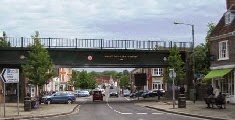 I
I
would like to think that any visitors that do travel to Hungerford
will find the town most agreeable. We have some fine antique outlets
which, if you look hard enough, do sell items connected with the
railway.
I have seen a couple of cast metal signs for sale plus other railway
memorabilia such as lamps and railway tickets. If you prefer model
trains then these can also be found in the town at reasonable prices.
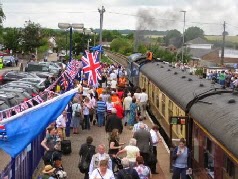 It
Itis quite fun to collect things connected with the railway as today in
many areas of the country the railways disappoint. I frequently
travel to Kent and some of the fine Victorian stations are dreadfully
neglected.
we do not care for the railways at all, there is a sense of nostalgia
when one looks at old photographs of the railway.
sturdy stations were built even for the smallest of villages, these stations were fully manned by caring railwaymen in company
uniforms.
if you read my article again in five years’ time (2020), and the
proposed development of the station area, maybe the station will
be complete, which would be delightful.
madness of electrification would have been stopped at Newbury and
visitors would able to travel the ten miles to Hungerford and sample
the delights of our town (there are many) and perhaps seek out their
own small piece of railway history when they visit one of the many
antique establishments in the High Street and beyond.
